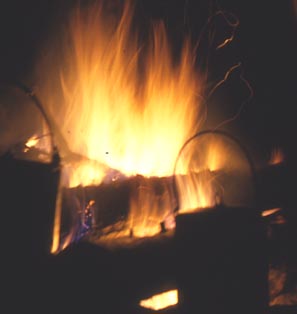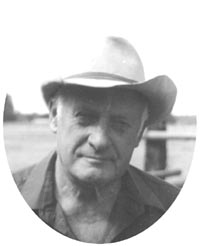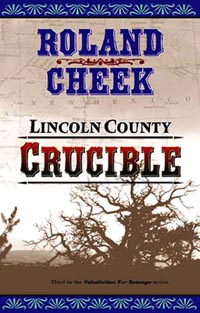a weblog sharing info on outdoor skills and campfire musing by a guy who spends a bunch of time in pursuit of both
CULTURE
WHERE -
TALES ARE TOLD OF
Welcome to Roland Cheek's Weblog
Roland is a gifted writer with a knack for clarifying reality. Looking forward to more of his wisdom
- Carl Hanner e-mail
While still in high school, over fifty years ago, the rumor was that a particularly good-looking girl smoked marijuana. I made a date with her because I wanted to push the envelope and learn more. She didn't smoke any weed that night and, in fact, had me take her home by 10 pm so, I later discovered, she could entertain her evening's 2nd date. The upshot of all the above? A half-century later, I still don't know what marijuana smells like. Nor have I discovered a use for any so-called recreational drug--perhaps because the addiction I acquired was a love for the outdoors. Maybe I'm lucky on so long-ago evening that girl had another date.
To acess Roland's weblog and column archives
Tip o' the Day
I've slipped in and out of my saddle a few thousand times, so I know it fits. But like most other horsemen, I don't know how to help anyone else find just the right saddle to fit them.
So to learn more about picking a saddle that fits, I asked a fellow whose advice I've respected enormously for well over forty years. Larry Gleason is a retired Ronan saddlemaker who also guided hunters during most of my years spent leading others to adventure in the Bob Marshall Wilderness.
"Find a saddle that fits, huh? Larry said. "Maybe that depends on how much a person plans to use it and what for."
I asked Larry to explain.
"There are three kinds of seats: cantle, center seat, and level seat. In a cantle seat, the front is high and it's deep back by the cantle. Center seats slope to the middle from both pommel and cantle. They're probably best for most people, expecially trail riders. Level seats are mostly for cutting horses, used with forward stirrups."
"How about the old style?" I asked. "High horn and cantle?"
"Again, that might depend on what you're doing with it. A person can get hurt with a tall horn or high cantle if their horse begins plunging around. Tall horns are usually double-dally horns that are for roping. Not much good for anything else. All a rider needs is a horn that's tall enough to get a good grip on."
"How about a high versus low cantle?"
"Should be high enough to come up on the buns, but not so high you can't swing in and out easy. Again, a shovel cantle can be a dangerous thing if you're straddling a rank horse. I'd say not over a 4-inch cantle."
"What about seat size?" I asked.
"Trees are measured from the base of the horn to the top of the cantle. But how comfortable you sit will also depend on location of swells. If swells are low, it'll spread your legs enough to be uncomfortable. Higher swells might allow you to slip easily into a smaller tree size.
I asked about stirrups?
"Most people say proper riding posture should be to sit erect and comfortable. You should be able to look down past your knees and see the tips of your toes, with the heel lower than the toe. By riding in this manner, most folks will have better leg contact with their horse."
Larry's advice is to buy only good quality saddles with a rawhide or fiberglass tree.
Knowing what the answer would be, I still asked about padded seats. The old saddlemaker stared steadily at me for several moments, then said, "Next quesion."
Thanks, Jane. I'm really enjoying Roland's stories -- this one about three travelers in the Bob with a wheelchair was amazing! / email from Fran Brinkley
* * *
Love your books. They are so much better than Louis L'Amour's / email from Josh Richmond
* * *
I found it. I liked it. And I sent a copy to Major Mitchell / email from Pat Nipper
NOTHING IS FOREVER
Early Romans expected their "Roman Peace" (Pax Romana) to always be civilization's guiding light--no matter how many neighboring cities and states had to be ground under their legions' heels to enforce it.
Less than a millenium later, it was the Avengers of Allah who thought their culture would forever reign supreme. More recently, communism's advocates anticipated their wave to be everlasting; that their ideology would "bury" all other forms of government.
What a laugh! History, if she teaches anything, teaches that nothing is forever. Fight it if you will. Shore up your current defenses with laws, rules, regulations, or armies; evolutionary change still occurs. Certainly it's possible to delay its process, but prevent change? Never!
Rome degenerated into just another Italian City-State. The people of once-victorious Islam are today's nationalistic laughingstocks. Christendom splintered into dozens of schisms and exploded with reformation. Communism toppled of its own weight.
Change is occurring even here in America, where the logistics for man's "best" system of governance developed. Consider the all-American principle of "Manifest Destiny"--the peculiar notion that we Americans are destined to rule the New World from "sea to shining sea." That embryonic notion received a kick in the rear when Bonaparte unloaded a Louisiana Territory he couldn't hold in any event upon eager Americans who thought they could. And a march to the western ocean began in earnest.
Somehow, though, Manifest Destiny was altered to mean different things to different people: trappers thought it their "right" to trap a resource to near-extinction; cattlemen thought it their 'right" to take and hold public domain for their exclusive use; miners considered it their "right' to gouge and tear and leave behind a ravaged land. An that thinking is still extant.
There are some today who hold it's their "right" to dewater a river to bedrock for irrigation. Others think it their "right" to pollute in the oft-misued name of progress. How and when did it happen that timber companies and their employees come to believe it their "right" to own the trees in America's National Forests that in truth are owned by all Americans, everywhere?
How is that multi-national energy companies deem it their "right" to pipe profits from public domain to far-off boardrooms--and damn the consequences to the land? How can it be anyone's "right" to strip mine grasslands or mountaintops, or bulldoze roads into undeveloped land, and leave slag heaps and barren landscapes and tailing ponds filled with poisonous liquids as a legacy to coming generations?
Chances are those coming generations will measure us not by the riches we extract or the monuments we construct, but by those debts we pile upon them to repay. And by the ravaged land we leave behind for them to do the best they can to reclaim.
Perhaps it's possible to reclaim, but can anyone but God actually restore?
What arrogance that we think we're competent arbiters for a future America! We didn't inherit this land from our parents, but borrowing it from our children!
Will we be considered good stewards during our generation's management? Or will our children curse us? Change is inevitable. Poor stewardship is not.
Roland Cheek wrote a syndicated outdoors column (Wild Trails and Tall Tales) for 21 years. The column was carried in 17 daily and weekly newspapers in two states. In addition, he scripted and broadcast a daily radio show (Trails to Outdoor Adventure) that aired on 75 stations from the Atlantic seaboard to the Pacific Ocean. He's also written upwards of 200 magazine articles and 12 fiction and nonfiction books. For more on Roland, visit:
www.rolandcheek.com
Recent Weblogs
Tuesday, May 13, 2008
for more info about these and other Roland Cheek books
There's a bunch of specific info about Roland's books, columns, archives and radio programs. By clicking on the button to the right, or below left, one can see Roland's synopsis of each book, read reviews, and even access the first chapter of each of his titles. With Roland's books, there's no reason to buy a "pig in a poke."
for detailed info about each of Roland's books
Read Reviews
Read their first chapters
For interested educators, this weblog is especially applicable for use in outdoor / nature classes, as well as for journalism students.
Roland, of course, visits schools. For more information on his program alternatives, go to:
Books 2 & 3 are set amid New Mexico's violent Lincoln County War
Book four in the Valediction For Revenge series, Gunnar's Mine, is set in Colorado mining country, as is the sixth and final book in the series, The Silver Yoke
Book five in the series is Crisis On the Stinkingwater. The book is set in Wyoming, around present-day Cody, in what is now called the Shoshone River Country
I knew you were a good writer, but I never before put you in the class of Michener and Clancy. You spin a good yarn and don't let it drop for a minute. You handle dialogue extremely well, and the action scenes are outstanding. You have no reason to venture so carefully into the world of novelists.
- Jack Oliver / Pittsburgh, PA
Next Week:
AGING'S ACCOMMODATION WITH REALITY
www.campfireculture.com
to send this weblog to a friend
to tell Roland what you think of his Campfire Culture weblog
source links for additional info
to visit Roland's newspaper columns and weblog archives








